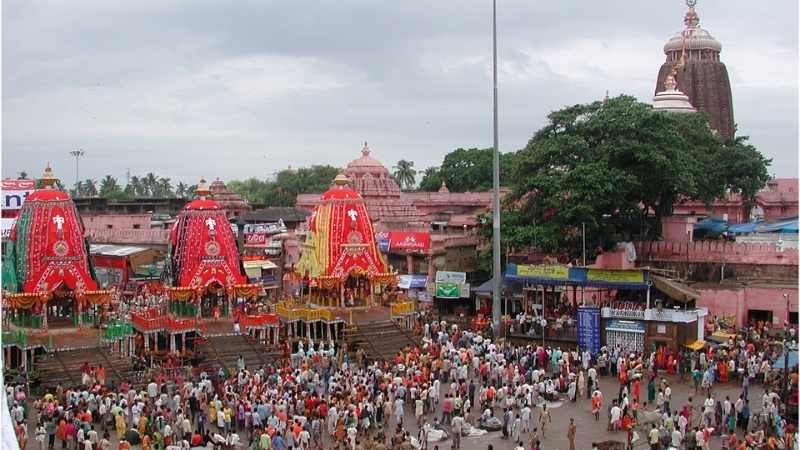10 Lines Essay on Rathayatra
- Ratha Yatra, the grand and colorful festival of chariots of Lord Jagannath, Lord Balabhadra and Devi Subhadra, is held on (Asadha Sukla, Dwitiya) the second day of bright fortnight of Asadha (June-July) every year.
- Millions of devotees from different parts of the country and abroad saw the wonder of world famous Car festival of Lord Jagannath at Puri. Odisha.
- This festival is also known as ‘Gundicha Yatra‘ and ‘Ghosha Yatra‘.
- As per the current tradition, Gundicha was the Rani (queen) of Raja Indradyumna, the legendary builder of the first temple. She had started this grand festival. Hence, this festival is also known after her name.
- On this day, the three deities are taken out from the main Temple, placed in three gorgeously decorated chariots and start their journey to Sri Gundicha Temple.
- The chariots namely Nandighosa, Taladhwaja and Devadalana are pulled by thousands of devotees from the Lion’s gate of the Shri Mandir(Temple) to Sri Gundicha Mandir (Temple) which is located at a distance of 3 kilometers.
- The 3 kilometers Grand Road , known as ‘Bada Danda’, between Jagannath Temple and Sri Gundicha temple, looked like a sea of people as the devotees filled to have a glimpse of the deities on the chariots.
- At Gundicha Temple, the deities stay for 7 days and perform their return journey on the 9th day which is known as ‘Bahuda Yatra’.
- The three chariots reach back the main temple in the evening. On the next day, the three deities are dressed in costumes of glittering gold ornaments and are worshipped by millions of devotees. This is known as the ‘Suna Vesha’.
- Next day morning, the three deities go back to their original place of the temple. Their arrival into the sanctum sanctorum marks the end of the Car festival.
Little More for Knowledge
- More than a religious festival, the Ratha Yatra is an eternal celebration of the divine values of love and compassion, of equality and fraternity.
- The general public is allowed to pull the chariots irrespective of caste, creed, sect, and religion and gender distinctions.
- This liberty indicates that the deity is equal for every person on earth and grants equal opportunity to all.
- Also, the festival signifies that the benevolent deities’ desire to come down to the level of the common man to share the joys and suffering of the common folk and to travel with them on the Grand Road for some time to reach Sri Gundicha Temple.
- Akshay Tritiya festival marks the beginning of the famous Car Festival of Lord Jagannath. Akshay Tritiya festival is observed on the third day of the bright half of the lunar month of ‘Baisakha’ of the traditional Hindu calendar. On this auspicious day the carpenters start building the chariots of Lord Jagannath, Balabadra and Subhadra. This day also commences the famous Chandana Yatra.
- Snana Yatra festival is observed on the full-moon day of the month of Jyestha (May-June). This is the bathing festival of the deities. On this day, the three deities move in colorful processions to the Snana Mandapa (Bathing pandal) where the deities are bathed with 108 pitchers of water drawn from a well near the Northern Gate. At the end of Snana Yatra day, the deities are supposed to fall ill (fever) and do not return to their pedestal. They stay away from the public view for a period of 15 days. This period is known as ‘Anabasara’ or ‘Anasara’ in local language. After this period, people get the first glimpse of their deities on the day before Rath Yatra, on this day the deities are re-painted and brought to the main platform for the devotees to see and pay homage which is called ‘Nava Yauvana Darshan’. This is also known as ‘Netrotsava’. Next day, the Ratha Yatra Festival is observed.
Spelling Rules
Spelling Rule- Before You Start: Part-A
Spelling Rule- 1: Syllables
Spelling Rule- 2 : English Words Never end with
Spelling Rule- 3 : “Y” acts as a consonant as well as a vowel
Spelling Rule- 4 : Two sounds of “C”
Spelling Rule- 5 : Two sounds of “G”
Spelling Rule- 6 : Magic-E/Silent-E
Spelling Rule- 7 : Drop the “e” rule
Spelling Rule-8: The 1:1:1 doubling-up rule
Spelling Rule-9: A E O U at the end of the Syllable
Spelling Rule-10: The Rabbit rule
Spelling Rule- Before You Start: Part-A
Spelling Rule- 11: The FLOSS/FLSZ rule
Spelling Rule- 12 : Use of C or K to pronounce K
Spelling Rule- 13: Use of /CH/ & /TCH/
Spelling Rule- 14: Use of /Cial/ & /Tial/
Spelling Rule-15: Two vowel’s sounds
Spelling Rule- 16 : Short Vowel Sounds
Spelling Rule- 17 : Long Vowel Sounds
Spelling Rule-18: Vowels in Short Words
Spelling Rule-19: Long Vowels’ Rules and Patterns
Spelling Rule-20: W is the Boss

